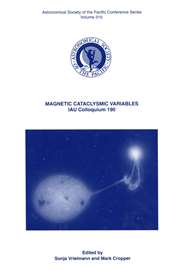No CrossRef data available.
Article contents
Radio Emission from Close Binary Systems and Novae
Published online by Cambridge University Press: 12 April 2016
Extract
This review of the radio emission properties of close binary systems and novae will be partly concerned with surveying the star systems that exhibit continuum radio emission, and partly concerned with discussing the implications of the observed radio emission. The phenomena we will encounter will range from purely thermal continuum radio emission for the case of ionized nova shells to strong, non-thermal continuum radio emission produced by relativistic particles in both ‘normal’ and X-ray emitting close binary systems. In keeping with the subject of this symposium, let me emphasize that all regions involving radio emission are from the portions of the stellar environment where Ne ≤ 1010cm-3, generally rather high in the stellar or systemic atmosphere; however, events more closely associated with the stars themselves are the root causes of the phenomena, supplying energy, mass, magnetic fields, and relativistic particles.
Information
- Type
- Part II: Cataclysmic Variables
- Information
- Copyright
- Copyright © Veröff. Der Remeis-Sterwarte 1977

